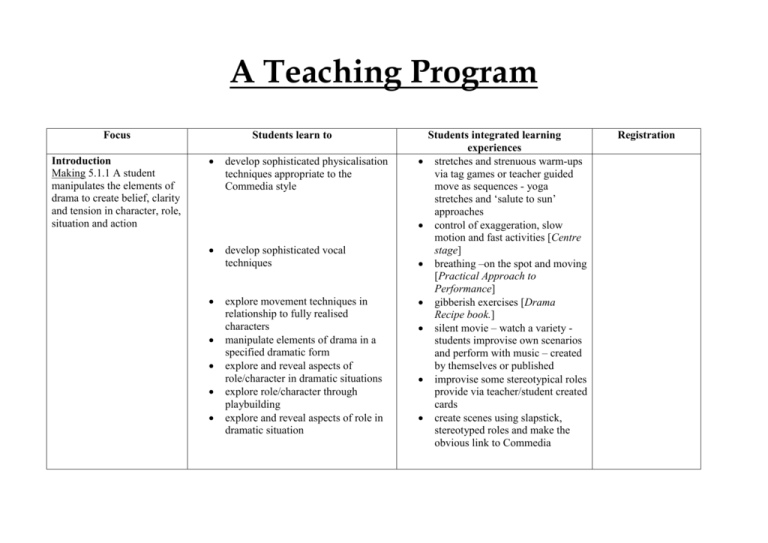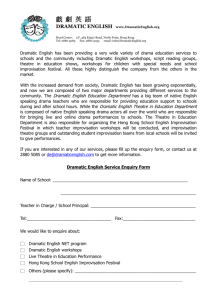Commedia dell`arte
advertisement

A Teaching Program Focus Introduction Making 5.1.1 A student manipulates the elements of drama to create belief, clarity and tension in character, role, situation and action Students learn to develop sophisticated physicalisation techniques appropriate to the Commedia style develop sophisticated vocal techniques explore movement techniques in relationship to fully realised characters manipulate elements of drama in a specified dramatic form explore and reveal aspects of role/character in dramatic situations explore role/character through playbuilding explore and reveal aspects of role in dramatic situation Students integrated learning experiences stretches and strenuous warm-ups via tag games or teacher guided move as sequences - yoga stretches and ‘salute to sun’ approaches control of exaggeration, slow motion and fast activities [Centre stage] breathing –on the spot and moving [Practical Approach to Performance] gibberish exercises [Drama Recipe book.] silent movie – watch a variety students improvise own scenarios and perform with music – created by themselves or published improvise some stereotypical roles provide via teacher/student created cards create scenes using slapstick, stereotyped roles and make the obvious link to Commedia Registration Stock Character: Zanni Performing 5.2.1 A student applies acting and performance techniques expressively and collaboratively to communicate dramatic meaning use breath and voice as key instruments of performance use movement and stillness to enhance performance create sub-text and emotional complexity in performance explore the dynamics of timing in performance apply acting techniques to create a stock character Arlecchino use breath and voice as key instruments of performance revisit introductory physical warm-up use neutral mask activities [Senior Drama Studies] text – enactment and observation approaches allow students to create a response with the neutral masks that explore status –subservient and dominant master /servant and adding various emotional overlays teacher led activities on Zanni Walks courtesy of Rudkin – Little Zanni, Big Zanni, Zanni running Teacher lead activities on Zanni jubilant, Vain Zanni and Soldier Zanni Allow students to respond to outlines of Zanni Improvisation exercises [Rudkin] Divide class into groups and have students create own situations – firstly without sound and then add in grammelot dialogue – side coach if necessary Watch the section from Ross Brown’s video on Arlecchino as it provides a clear example of the style and realisation of the servant character Allow students to work with his physicalisation to realise the movement and body language of the character explore the dynamics of timing in performance Il Dottore Panatalone Apply acting techniques to create a stock character explore the dynamics of timing in performance apply acting techniques to create a stock character Stock Character Il Capitano Making 5.1.4 A student explores, structures create a dynamic actor-audience relationship in the performance situation Research and apply concepts of relevant drama practitioners and their works Make use of the Improvisation activity provided by Rudkin Provide examples of Lazzi and allow students to enact Students can use sample monologue as a model for a selfdevised response Students encouraged to devise and perform and appreciate/evaluate using Rudkin, use role cards with his movement and stance on it and allow students to create this character [he is easy to do] provide and allow students to enact improvisation activities repertorio activities sample dialogue [Rudkin] use Ross Brown’s section on Pantalone – the style is right and students enjoy his realisation Allow students to move and vocalise as Pantalone Divide class into threes and issue sample dialogues that includes Zanni, Il Dottore and Pantalone – students to work on creating situation build on research already done by students - introduce Il Capitano who is a political stock character to place him in context and refines ideas using dramatic forms, performance styles, dramatic techniques, theatrical conventions and technologies Performing Performing 5.2.2 A student selects and uses performance spaces, theatre conventions and production elements appropriate to purpose and audience explore the nature of different theatre companies and their dramatic function in relationship to an audience manipulate a variety of scene and plot structures in order to structure particular dramatic forms introduce and workshop his movement which is engaging and flamboyant provide his characteristics 1. politic 2. total coward 3. really courageous 4. non-masked – Il Cavaliere briefly touch on improvisation and repertorio activities Focus and create on a Canovaccio which uses any combination of the characters studied so far E.g. Il Capitano. Zanni and Arlecchino in a recruitment type segment – military power Eg Il Capitano, Pantalone and Arlecchino with a mixed message scenario - power Colombina explore and perform in a variety of performing spaces use dramatic techniques suitable to explore different spaces, dramatic meanings and audience relationships as she is the generic of the male zanni revise the zanni movement and add in her “flick of foot” provide her relevant dossier and take note that she is the “ “ only lucid, rational person in the dramatic form”– see page 130 of Rudkin Students to be given a sample canovaccio and should then be encouraged to create their own. Divide into groups Emphasis to be placed on using an outside or unusual performing space as use techniques such as juxtaposition to create contrast in dramatic works adapt features of established dramatic forms to create their own groupdevised works manipulate a variety of dramatic and theatrical techniques to enhance dramatic texts in different forms and styles demanded by the ‘locus’ of the style and supported by the evidence in their research Students to improvise a brief scene set in modern times to focus on the Eternal Love Triangle and mistaken identity. Then juxtapose a piece in the style of Commedia using any of the Stock characters - must include Colombina The Individual Task Appreciating 5.3.3. A student analyses and evaluates the contribution of individuals and groups to processes and performances in drama using irrelevant drama concepts and terminology The group task Appreciating 5.3.2. A student analyses the contemporary and historical contexts of drama Performing 5.2.3 [5.2.1 and 5.2.2 are implicit outcomes assessment of individual performance skills] A student employs a variety of dramatic forms, performance styles, dramatic techniques, theatrical conventions and technologies to create dramatic meaning investigate, analyses and synthesise dramatic ideas through enactment and workbook research the contribution of various historical drama groups use appropriate drama terminology deconstruct and analyses an historical dramatic form understand the historical context of Commedia select, explore and use specific performance style demonstrate acting skills appropriate to the chosen dramatic context and to communicate with an audience use knowledge and understanding of dramatic forms and performance styles to shape and refine their own playbuilding and performance work students provided with research task need to hand in written response need to provide persona delivery of information Task Description Students will be divided into groups draw on all theoretical and experiential learning to enact the specific performance style of Commedia select what stock characters will be integrated into the performance demonstrate an awareness of the function of relevant characters and use appropriate acting skills create an original plot structure using traditional models incorporate and manipulate the elements of drama in the performance. use stagecraft and rehearsal skills appropriate to process reflect on their work through entries in the log and also provide assessments of their peer’s work.








